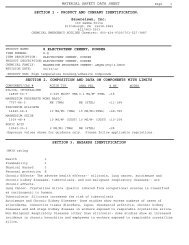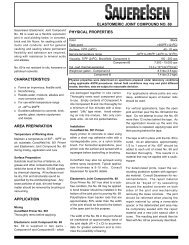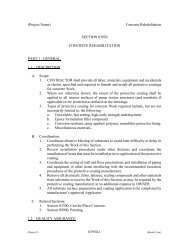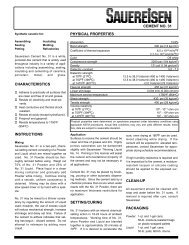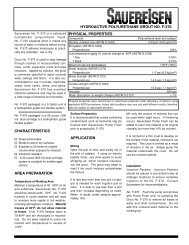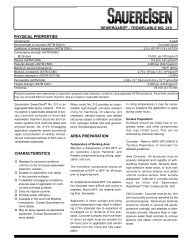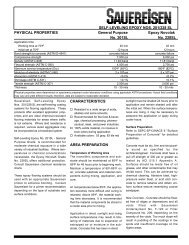The Problems with Protecting Wastewater Treatment ... - Sauereisen
The Problems with Protecting Wastewater Treatment ... - Sauereisen
The Problems with Protecting Wastewater Treatment ... - Sauereisen
Create successful ePaper yourself
Turn your PDF publications into a flip-book with our unique Google optimized e-Paper software.
Winner of the2006 OutstandingSSPC Publication AwardPCL JJOURNAL OF PROTECTIVE COATINGS & LININGSReprinted from October 2004Out of Sight,Out of Mind,and Often Out of Order:<strong>The</strong> <strong>Problems</strong> <strong>with</strong><strong>Protecting</strong> <strong>Wastewater</strong><strong>Treatment</strong> PlantsBy Gary Hall, <strong>Sauereisen</strong>, Inc.
Out of Sight, Out of Mind,and Often Out of Order:<strong>The</strong> <strong>Problems</strong> <strong>with</strong> <strong>Protecting</strong> <strong>Wastewater</strong><strong>Treatment</strong> Plants(above) Large wastewater treatment in Arizona <strong>with</strong>(tan) epoxy liner appliedCollections. Drains. SewerLines. By whatevername they are called,they and their associatedtreatment plants presentunique protection andmaintenance challenges. Imagine beingasked to put a coating on concrete thatis saturated <strong>with</strong> water, covered <strong>with</strong>grease and a nasty biofilm, heavilyattacked by sulfuric acid, and contaminated<strong>with</strong> bacteria. Imagine, too, thatsurface preparation techniques at bestremove degradated concrete and surfacecontaminants but have no effect onthe level of moisture in the substrate orthe degree of subsurface microbial colonization.Suppose your coating has tocure at cool temperatures in an environmentthat is at more than 90% RH andfilled <strong>with</strong> hydrogen sulfide. That isenough to make even hardened coatingapplicators nervous and the best coatingformulator sweat. Yet those are preciselythe conditions found in wastewatercollection and treatment systems.A system that is out of sight and outof mind is often out of order. To saythere are “coating issues” in wastewatertreatment systems is a classic under-2By Gary Hall, <strong>Sauereisen</strong>, Inc.statement. Contributing to those issuesare two underlying factors—a basic lackof understanding of the cause of deteriorationon the part of the industry andits specification writers, and an all toocommon material specification for theconcrete that demonstrates the combinedeffects of insufficient informationand a resistance to change. This articlehighlights these issues, outlines the corrosionmechanisms involved, and discussessubstrate specifications and coatingselection, including properties andchemistry.Waste solids + microbesJPCL / October 2004 / PCEwateragitation(above) Gravity thickener tank(rehab.) lined <strong>with</strong> 20 mils( 1 ⁄2 mm) of epoxy(left) Underground clarifierlined <strong>with</strong> 1 ⁄4-inch (6-mm)epoxy mortarPhotos courtesy of the authorGerms and Other NastiesAs one would suppose, the environmentof a sewage collection system isone of the least sterile imaginable.Perversely, it is the very lack of sterilitythat at once makes the system workas efficiently as it does and that is thecause of myriad problems. <strong>The</strong> processbegins <strong>with</strong> decomposition of solidwastes in the sewage. To travel fromany particular home or building on thesystem to the wastewater treatmentplant (WWTP) requires several days,on average. During this time, anaerobicbacteria, which function in an airlessenvironment, are present in the solidwastes, along <strong>with</strong> water-aided dissolutionand agitation due to flowing andtumbling through the pipeline. <strong>The</strong>sefactors cause the waste solids to breakup. <strong>The</strong> microbes release hydrogen sulfide(H 2 S) as they form sulfate-containingorganic compounds:<strong>The</strong> bacterial digestion of the solidsforms polythionates and other sulfates,H 2 S + polythionates + sulfates
some of which are deposited on theconcrete.In the air spaces above the sewage,water vapor (H 2 O) and carbon dioxide(CO 2 ) are ubiquitous. Collecting on theconcrete, the condensed H 2 O dissolvesboth the CO 2 and H 2 S, resulting in asolution of H 2 S and carbonicacid (H 2 CO 3 ).Metals are also used in variousways throughout wastewatertreatment systems. Concreteusually contains metallic reinforcement(rebar). Ladders, sluicegates, and other metallic substratesoffer opportunities forcorrosion. Microbiologicallyinfluenced corrosion (MIC) onmetals is no different than anyother electrochemical attack. <strong>The</strong>microorganisms involved cancause the same sort of corrosionproblems seen in other environments.<strong>The</strong>y may accelerate corrosionfrom other sources, suchas industrial discharges.Corrosion phenomena such aspitting, gaseous concentrationcells, crevice corrosion, exfoliation,and selective de-alloying areall found <strong>with</strong> MIC.Most instances of MIC resultfrom highly complex interactionsbetween groups ofmicroorganisms, not all ofwhich are bacteria. Molds, mildew,fungi and yeasts, and many species ofbacteria can contribute to corrosion.Due to this multiple organism environment,simply testing a material’s resistanceto H 2 SO 4 or one microbe doesnot replicate field conditions. <strong>The</strong> onlymeaningful test is in fact multiple fieldexposures in a variety of locales andsystems.<strong>The</strong> presence of multiple species ofmicroorganisms may complicate surfacepreparation. Some microorganismsare anaerobic and may infiltrate concrete,which typically has upwards of10% total porosity as measured byASTM C-20, Test Methods forApparent Porosity, Water Absorption,Apparent Specific Gravity, and BulkDensity of Burned Refractory Brickand Shapes by Boiling Water.Different microbial species willintroduce other chemical species. ForConcrete Pipeexample, halophillic bacteria may beassociated <strong>with</strong> chlorides or other halogens.Due to the highly complex interactionsbetween groups of microorganisms,the chemistry at the substrate/biofilm interface is far different than ifthe biofilm was not present. <strong>The</strong> differencesmay include pH, dissolved oxygen,organic and inorganic compounds,and entrapped/ dissolved gases such asH 2 S.Virgin concrete, dependent upon themix design and degree of carbonation,has a pH of 12.5 to 13.5. <strong>The</strong> alkalineconcrete begins to react <strong>with</strong> the carbonicacid/ H 2 S condensate and thesurface pH begins to drop. Unhindered,these reactions will eventually lowerthe pH to about 8.Also ubiquitous in the air space arethe Thiobacillus bacteria. As the pluralform indicates, there are more thanone type, or strain, of Thiobacillus,including one called Th.Concretivorous, or “concretedevouring” Thiobacillus. <strong>The</strong>sebacteria respire H 2 S and consumepolythionates. <strong>The</strong>ymetabolically reduce thesesulfates and produce sulfuricacid (H 2 SO 4 ), which has a concentrationthat is straindependent. <strong>The</strong> concentrationof H 2 SO 4 ranges from 1.6% to60.40%. Our friend Th.Concretivorous secretes>40wt% H 2 SO 4 . This sulfatereducingbacteria (SRB) is aerobic,functioning in a gaseousenvironment, usually one thatincludes oxygen. <strong>The</strong> SRBlodge on the concrete abovethe sewage, where theysecrete their H 2 SO 4 waste. Ofcourse, the H 2 SO 4 greatlyaccelerates the corrosionprocess, the rate of which isultimately dependent uponthe strain of bacteria presentand how successful it hasbeen at proliferation. Thisphenomenon is also MIC.CondensedH 2 0, H 2 C0 3 , H 2 SReleased H 2 SWaste SolidsDifferent microbial species will introduce other chemical speciesNew concrete after abrasive blasting toremove laitance and expose bugholesSame surface after filling voids/bugholes<strong>with</strong> epoxy filler compoundAn Underlying ProblemAfter WWII, specification writersbegan to call for the use of Type IIportland cement in concrete sewerpipes and appurtenances. Type II portland,a so-called “sulfate-resistant”cement, was chosen <strong>with</strong> the mistakenbelief that it would <strong>with</strong>stand acidsbetter than Type I, the “standard”cement used in construction. ASTM C-150, Specification for PortlandCement, does promote the resistanceof Type II to neutral and alkaline sulfatescommon to ground water.JPCL / October 2004 / PCE3
Out of Sight, Out of Mind, and Often Out of OrderHowever, all portland cement is strongly alkaline and willreadily react <strong>with</strong> even the weakest H 2 SO 4 . A study publishedin 1993 by the author 1 and G. Maloney illustratesthat Type II deteriorates to a greater degree than Type Iafter 6 months’ exposure to a H 2 SO 4 solution that wasonly 5wt%. After one year the Type II had suffered significantlymore strength and mass loss than Type I, which wasitself essentially destroyed. Figures 1 and 2 illustrate theeffect of an even weaker 1% H 2 SO 4 solution on Types I & IIportland. Figure 3 is a control mix of Type II unexposed.Figures 4 and 5 demonstrate the effect on calcium aluminatecements. As can be seen in Fig. 5, the calcium aluminatecements are rapidly attacked at 40% H 2 SO 4 , the acidconcentration secreted by Th. Concretivorous.Much of the municipal collection infrastructure in theUnited States and elsewhere has suffered significant corrosionloss because of the initial ignorance of the propertiesof portland cement, in general, and of Type II, in particular,and a misunderstanding of the overall destructive mechanismincluding the microbial role. Many large sewer lineshave collapsed as a result. Inertia has kept the process running.Inertia on the part of industry “experts” has keptthem from correcting past errors in design specificationsand material choices. Inertia on the part of system owners,because the system is “out of sight,” has created chronicfunding shortfalls and an unwarranted and ultimatelyunwise dependence upon contractors for material selectionrather than qualified engineers. <strong>The</strong> municipalities andtheir design engineers should have the ultimate objective ofobtaining the lowest total cost/unit area over the structure’sexpected life. In reality, they often jointly conspire <strong>with</strong> thecontractor to obtain the lowest installed cost/unit area. <strong>The</strong>former is good engineering practice and money management.<strong>The</strong> latter ignores known facts and is a gamble thattoo often proves costly.To Coat or Not To Coat?<strong>The</strong> environment and the elements of the corrosion processexist throughout the collection system. Moreover, theyexist from one system to another in areas as different asAlaska, Puerto Rico, and Arizona. Regardless of locale, thesame microbes are present; H 2 S is given off; polythionatesare formed; and H 2 O is present. Yet some systems have littleor no corrosion while others lose six or more inches ofconcrete in less than four years. In some systems, one areaexhibits severe corrosion while another shows none. Giventhis, how do we decide whether to coat or not to coat?With what do we coat? How do we specify the coating?% change in weight% change in compressive strength1% H 2 SO 4Type #1 Type #2Figure 1: Effect of Weak H 2 SO 4 on Weight of Types I and IIPortland Cement over Time1% H 2 SO 4Type #1 Type #2Figure 2: Effect of Weak H 2 SO 4 on Compressive Strength of Types I and IIPortland Cement over TimeWhat properties are needed? How do we rehabilitate substratesprior to protecting them?History is a valuable tool. History can provide clues thatenable us to evaluate data, much of it anecdotal in our case.<strong>The</strong> history of a given collection system will obviously indicatewhere the effects of corrosion have been observed. Thatis one prong of the multi-pronged problem. Until relativelyrecently, most pipeline interiors were rarely if ever seen onceplaced in the ground. We only knew about problems whenthey produced observable effects like collapse and leakage.Today, the means exist to visually inspect pipeline interiors inplace. This allows for the collection of data and decision makingbased upon this data.Some industrial companies and a few technical organizationshave taken the lead in determining the cause of corro-4JPCL / October 2004 / PCE
Out of Sight, Out of Mind, and Often Out of OrderBottom side view of 12-inch x 12-inch x 6-inch (30-cm x 30-cm x 15-cm)reinforcedconcrete steel beam in wet well. Six years’ service in Louisiana wastewatertreatment collection system. Concrete loss is greater than 4 in. (10 cm)sion and developing data or means to combat the corrosion orprevent it. Organizations such as NACE International, WaterEnvironment Federation (WEF), and the InternationalConcrete Repair Institute (ICRI) have provided a public forumto help elucidate the problems, causes, effective remediation,and quality control. Others such as SSPC: <strong>The</strong> Society forProtective Coatings have helped train the industry and its consultantsand contractors to correctly specify and apply coatingsfor corrosion protection.We now recognize and understand the conditions that leadto MIC and the mechanisms involved. Where do we applyprotective coatings? As stated above, <strong>with</strong>in one collectionsystem, there can be some areas exhibiting severe corrosionand others exhibiting very little or even none. Examination ofhundreds of systems, in person or by video, has given usenough data to make some generalizations about the conditionsand locations likely to corrode. One very importantcaveat underlying these generalizations is that fixing theproblem in one area may exacerbate the situation downstream.<strong>The</strong> bacteria may prefer one area to another due to alocalized variable such as a higher H 2 S concentration.Eliminating their growth support platform, for example, byapplying a coating, may cause them to move on to a lessdesirable area. Being highly adaptable, they lodge, proliferate,and start the MIC process in a new area. Table 1 lists some ofthe Th. bacteria and their ideal growth conditions; Table 2lists some areas especially prone to MIC.As mentioned above, some parts of the wastewater treatmentsystem will not be subject to corrosion. Indeed, sometimesan entire collection and treatment system may haveonly limited corrosion. Why does one system in Vermontshow no corrosion, yet a system in Florida shows severe corrosion?We now know that systems <strong>with</strong> forced-mains willundergo much less MIC compared to gravity-flow systems.When sewage is pumped through forced-main systems, thepipe is full and the pressure of the flowing water helps todilute any acid present and to remove biofilms. <strong>The</strong> more oftenCompressive Strength (psi)Compressive Strength (%)Compressive Strength (%)70006000500040003000200010000+50- 5-10-15-20-25-30-35-40-45-50+50- 5-10-15-20-25-30-35-40-45-50JPCL / October 2004 / PCE1 3 7 14 21 28Time (Days)Fig. 3: Change in Strength vs Time1 3 7 14 21 28Time (Days)Fig. 4: Change in Strength of Calcium Aluminate Cementvs Time for 37.5% HCI Immersion1 3 7 14 21 28Time (Days)Fig. 5: Change in Strength of Calcium Aluminate Cementvs Time for 40% H 2 S0 4 ImmersionConcrete comparator panels from ICRI being usedto determine adequacy of surface preparation5
Out of Sight, Out of Mind, and Often Out of OrderTable 1: Environmental Conditions Promoting Thiobacillus GrowthParameterMetabolicprocesspHInitialOptimum GrowthSlow GrowthTemperatureOptimum GrowthSlow GrowthThiobacillusconcretivorousOxidizes thiosulfateselemental sulfur, sulfides7 to 82 to 40.6>550–75 F (10–24 C)85–98.6 F (29–37 C)75–85 F (24–29 C)ThiobacillusthioparansOxidizes thiosulfatesto elemental sulfurand sulfate7 to 84 to 5>9,
Out of Sight, Out of Mind, and Often Out of Ordereffect. Table I lists the environmental conditions most favorablefor Thiobacillus growth. If one system is exposed to significantlywarmer temperatures, the bacteria proliferatemore efficiently than in a cooler climate. For example, asystem in Vermont may see only 50 F (10 C) or more threemonths/year, while the same size system in Puerto Ricomay never fall below 50 F (10 C). <strong>The</strong> Puerto Rico systemwill see significantly increased corrosion compared to theVermont system.Some locales have high levels of sulfur and H 2 S in theirwater supply. Coastal areas may have chloride in the system.Farming communities will have phosphates andnitrates from fertilizers. Each of these scenarios creates anadditional potential for MIC. Halophilic bacteria will generateHCl, while others utilize the phosphates and nitrates.Recently, the industry has seen a proliferation of coatingsRehabilitation of a brick manhole—counterclockwise, from left top (p. 44):Brick manhole <strong>with</strong> severely deteriorated mortar joints; lined <strong>with</strong> cementbasedepoxy repair material at approximately 1/4-inch (6 mm); being coated<strong>with</strong> rotary spray-applied epoxy at approximately 125 mils (3 mm); completedrehabilitationTable 3: Properties and Test MethodsSpecified for 65-Mil (1.5-mm) CoatingPropertyCompressive StrengthFlexural StrengthModulus of Elasticity, FlexTensile StrengthTensile ElongationHardnessBondWVT/PermeabilityCoating #1C-579C-580D-522C-307/D-638D-638D-2240D-4542D-1653Coating #2D-695 (Property notneeded)D-790—D-638D-638D-2240D-4541D-1653being touted for service in municipal wastewater systems.Some are coatings already in use in other industries. A manufacturer<strong>with</strong> little or no knowledge of the issues will thenbegin to recommend such systems for the severe environmentsof wastewater treatment plants. Other coatings weredeveloped specifically for this market <strong>with</strong> full knowledge ofthe MIC process and application and cure challengesinvolved. Still others are copies of other manufacturers’products, offering no technology base other than some skillin cook-book blending. Specifiers of coatings and systemowners have only a limited ability to evaluate the success ofthe many coatings available, much less the technologybehind the coating or its chemistry—thus the need for strictlyenforced specifications.At this junction, some system owners and consulting engineerstake a step down a slippery slope by asking their contractorsto choose a coating. Sometimes the contractor evendetermines substrate repair and acceptability. As skilled assome contractors are, especially those who are SSPC-trainedand certified, they are not qualified to make recommendationson matters needing a scientific background. When thecontractor becomes the coating consultant, concerns aboutchemistry, materials science, corrosion science, microbiology,and civil engineering are ignored. Other issues, such as coatingcost, ease of use, and personal/ business relationshipsbecome the overriding ones.While cost issues and applicator friendliness are legitimateconcerns, they are merely additional factors. When acoating is chosen by price alone, a prime responsibility ofengineers and managers is compromised. A financial analysisthat ignores cost/ unit area/year of service life is at bestan analysis of questionable worth.As for user friendliness, the author’s experience has beenJPCL / October 2004 / PCE7
Out of Sight, Out of Mind, and Often Out of Orderthat most coating manufacturers makecoatings that are simple enough toallow for proper application easily.Failure to do so is tantamount to guaranteeinga poor sales growth. <strong>The</strong> problemin this regard usually relates to oneof four factors.• A preferred contractor or low-bidderdoes not have the required equipment.• A preferred contractor or low bidderdoes not have the required skill levels orexperience.• <strong>The</strong> contractor does not have sufficientmoney in his bid to support materials ofrequired/specified quality.• <strong>The</strong> contractor does not have a preferredcontractor discount available <strong>with</strong>the specified coating manufacturer.PropertiesEngineering consultants or system ownersspecify the properties of the materialsto be used along <strong>with</strong> “appropriate”test methodology. Table 3 shows twodifferent sets of engineering specifiedproperties and the ASTM test methodsused by their respective manufacturers.Both are for a 65-mil (1.5-mm) sprayappliedepoxy coating for manholerepair. <strong>The</strong> set of properties on the leftis generated via ASTM methods predominantlyunder ASTM committees C-3, Committee on Chemical-ResistantNonmetallic Materials, and D-1, Paintand Related Coatings, Materials, andApplications. <strong>The</strong> set on the rightincludes types of data generated viamethods for molded plastics and preformedplastics under D-20, on plastics.“So what,” you say. <strong>The</strong> method bywhich a given mechanical property isdetermined has a statistically profoundeffect upon the result. Factors such assample shape, size, sample preparation,surface area/volume ratio, speed atwhich loads are applied, and the mannerof testing all have an effect on theresults obtained. <strong>The</strong> different ASTM8Table 4: Compilation of Microbiological Species Identifiedin Environments Associated <strong>with</strong> Corrosion FoulingOrganismAchromocacter Spp.Aerobacter Spp.Aerobacter aerogenesAlcaligenesBacillus Spp.Bacillus cereusBacillus subtilisBeggiatoaChromobacteriumClostridium Spp.CrenothrixDesulfotomaculum Spp.Desulfotomaculum nigrificansDesulfotomaculum orientisDesulfovibrio Spp.Desulfovibrio africannusDesulfovibriodesulfuricansDesulfovibrio salexigensDesulfovibrio vulgarisDiplicoccus Spp.Diplicoccus pneumoniaeEscherichia Spp.Escherichia coliEscherichia freundiiFerrobacillus ferrooxidansFlavobacterium Spp.Flavobacterium hydrophiliumGallionella ferrugineaKlebsiella Spp.Klebsiella pneumoniaeLactobacillusLepthothrixmethods utilize different testing techniquesand sample preparation methods,and are unable to determine propertiesat a specific age. In addition,machining of samples introduces potentialerror due to the effect of frictionalforces <strong>with</strong> a cutting device. ThisJPCL / October 2004 / PCEOrganismMicrococcusMicrospiraNocardia Spp.Paracolobactrum Spp.Proteus Spp.Proteus morganiiProteus vulgarisPseudomonas Spp.Pseudomonas aeruginosaPseudomonas oleovoransSalmonella Spp.Sarcina Spp.Shigella Spp.SphaerotilusSpirillumSporovibrioStaphylococcus Spp.Staphylococcus albusStaphylococcus aureauStaphylococcus citreusStreptociccus Spp.Thiobacillus Spp.Thiobacillus concretivorousThiobacillus thiooxidansThiobacillus thioparusThiothrixVibrio Spp.YeastFungiCladsporium resinaeCephalosporium Spp.means that a particular property measuredby a D-20 method will not necessarilycorrespond to the same propertymeasured by a C-3 methodolgy.Which methods are appropriate? Weare dealing <strong>with</strong> a corrosion-resistantcoating, not a molded or machined plas-
Out of Sight, Out of Mind, and Often Out of Ordertic part. <strong>The</strong>refore, the methodologiesof C-3 and D-1 pertain. Plastic testmethods are wholly inappropriate andmisleading. <strong>The</strong> properties requiringspecification are those important to theperformance in service. Let’s examinesome properties, needed values, andtheir appropriateness to their performancein service.• Thickness—usually less than 125mils (3 mm)— is an important propertybecause some other properties aredirectly proportional to the thickness,e.g., wear, permeability, microbial barrierefficiency, and completeness of coverage.Thickness should always be specifiedas dry film thickness (DFT). Onnew, smooth concrete, a thickness of30–40 mils (~1 mm) will work well.When the concrete is rougher than a36-grit sandpaper, thickness needs tobe increased to 60–120 mils (1.5–3mm).• Compressive strength—Since appliedcoatings in wastewater treatment systemsare not subjected to more thanminor levels of compressive forces, thisproperty is not one that is truly needed.Its value lies in the fact that engineersthink they understand its meaningand it is a cheap and easy test torun as a QC/QA test. But we are dealing<strong>with</strong> coatings, high-build paint, ifyou will. It makes no more sense tospeak of the compressive strength ofthese coatings than it does for paint.• Flexural strength—Since flexing andvertical misalignment occur regularlyin buried wastewater treatment andcollection systems, both the flexuralstrength and the tangent flexural modulusof elasticity are valuable propertiesto know. <strong>The</strong>se can be accuratelydetermined for coatings at thicknessesof 50 mils (1.2 mm) or greater. Valuesof 4,000 psi or greater for flexuralstrength and 5 x 10 6 psi or less forflexural modulus are good.Tensile strength—One of the mostimportant of mechanical properties,tensile strength is needed to calculateoverburden-bearing capacity and is ofparamount importance to resistance toground water infiltration. Tensilestrengths of 1,800 psi are consideredexcellent.• Bond strength—<strong>The</strong> bond of thecoating to the substrate is perhaps thekey element to achieving a long servicelife. Loss of bond is the most commonmode of failure for coatings. Bondstrength to wet concrete should exceedthe cohesive strength of the concrete,usually above 400 psi.• Permeability—Calculated from watervapor transmission (WVT) rates andpermeance, permeability is the propertythat controls passage of corrodentsthrough the coating to the substrate. Ifall other properties and chemistry areequivalent, the coating exhibiting thehighest permeability will typically failfirst. A permeability of
Out of Sight, Out of Mind, and Often Out of Ordermicrobes at work as well. For example,Desulfovibriodesulfuricans actuallymigrate through capillary and gel poresin the concrete to lodge on embeddedreinforcement. <strong>The</strong>se SRB use iron (Fe)to catalyze the reduction of polythionatesto H 2 SO 4 . <strong>The</strong> H 2 SO 4 is secreteddirectly on the iron and causes it to corrodeand expand as it does. <strong>The</strong> volumetricexpansion can be up to twelvetimes the original volume of the reinforcement.This expansion can generatetremendous stresses in the concrete,causing it to crack concurrent <strong>with</strong> thereinforcement. When this occurs, thereinforcement must be exposed, cleanedand repaired, grouted for stress relief atsplices, and recoated <strong>with</strong> concrete. Tocoat the concrete <strong>with</strong>out doing so is tovirtually guarantee future failure. <strong>The</strong>concrete on both sides of the reinforcementneeds to be repaired.Although not specifically discussedin this paper, many microorganismshave been associated <strong>with</strong> corrosion,and the reader should be aware ofthem. Table 4 lists some of thesemicroorganisms.CoatingsNow we know what happened andwhy, and we have discussed neededphysical properties, corrosion resistance,and substrate issues. It is time toconsider coating types. For municipalcollection systems <strong>with</strong>out industrialdischarge, a high quality bisphenol Aepoxy cured <strong>with</strong> a cycloaliphaticamine or equivalent will performadmirably for many years. <strong>The</strong> authorhas personally inspected such linings inservice for more than 20 years <strong>with</strong>outany maintenance. Today, plural-componentspray-applied polyureas are beingused in a few municipalities. <strong>The</strong>y havehad adhesion problems due to the factthat they cure so rapidly that they cannotadequately wet the concrete and10develop the needed adhesion. Some arenot of sufficient quality to <strong>with</strong>standhydrolysis—dissolution by water.Several companies are working onthese problems <strong>with</strong> varying degrees ofsuccess. Polyurethanes are also beinglooked at for this application. Somecoatings based on novolac epoxy resinsare being installed. While these resinswill resist higher concentrations ofmost acids, they do have a potentiallyserious drawback. Permeability testingshows that novolac epoxies are actuallymore likely to be permeable to H 2 Sthan are bisphenol A epoxies.Conclusion<strong>Wastewater</strong> collection and treatmentsystems present very difficult challengesto stakeholders such as owners, engineers,coatings manufacturers, andinstallers. This article has outlined someof these naturally occurring challenges. Itis the responsibility of each of thesestakeholders to become aware of thesechallenges and incorporate the necessarytechnology to <strong>with</strong>stand the difficultenvironments. <strong>The</strong> owner must ensurethat cost/unit area/year of service isthe determining factor in awarding bids.Owners need to be more judicious incontractor selection. Engineers need tobecome familiar <strong>with</strong> the conditions presentand research available materials toensure quality specifications. Engineersneed also to apply their knowledge andskill in evaluating reported propertiesand test methodologies. Contractorsneed to develop the necessary skill set toapply the specified coatings or theyshould not be allowed to bid a project.Only an unwise contractor voluntarilyplaces himself at risk by becoming the defacto consultant. He isn’t being paid totake that financial risk or to risk civilpenalties for failure. <strong>The</strong> coatings manufacturerhas to know the exposure conditions,application and cure conditions,JPCL / October 2004 / PCEand required properties in order todevelop a quality coating. He needs tohave a knowledge of coatings chemistryand to be able to evaluate the effect ofthe environment upon the coating. <strong>The</strong>coatings manufacturer also needs tounderstand materials science in order todetermine what properties are neededand to choose the correct methodology.Short cuts lead to short coating servicelife.Reference1. G. Hall and G. Maloney, “CorrosionRates of Uncoated Concrete for SelectedCorrodents,” Journal of Protective Coatings& Linings, December 1993, p. 61.Gary Hall is currentlyManager of OrganicTechnology andManager of Environment,Health andSafety at <strong>Sauereisen</strong>,Inc. (Pittsburgh, PA).<strong>Sauereisen</strong> manufacturesceramics, refractories,cements, andGary R. Hallcoatings. Mr. Hall is responsible for productdevelopment and improvement for<strong>Sauereisen</strong> and manages the Research andDevelopment efforts for the organic productline. He has been <strong>with</strong> <strong>Sauereisen</strong> for 36-years and is a graduate chemist from theUniversity of Pittsburgh. He is active in theNational Association of Concrete Engineers,several ASTM Committees, AmericanInstitute of Chemical Engineers, and theElectrostatic Discharge Association. Mr. Hallis also a contributing editor for JPCL and hastwice been the recipient of the JPCL Editors’Award. His areas of special interest includecement and concrete technology, corrosionscience and control, polymer science, andnanotechnology.
PRODUCTS FOR RESTORATION AND PROTECTION OF WASTEWATER INFRASTRUCTURESLININGS – INFILTRATION AND CORROSION PROTECTIONSewerGard Epoxy Systems No. 210Self priming, moisture tolerant epoxy systems that are completely resistant to the micro-biologically induced corrosion common to municipalwastewater applications as well as provide an infiltration barrier. <strong>The</strong>y are available in aggregate filled trowel (No. 210T) and rotaryspray (No. 210RS) versions, as well as a fiber-filled airless spray version (No. 210S). <strong>The</strong> No. 210RS allows manholes to be efficientlylined from street level <strong>with</strong> minimal entry into the manhole. <strong>The</strong>se products will bond to damp concrete and cure in the presence of moisture.An optional topcoat (210G) provides a more smooth surface for greater cleanability. This 100% solids product can be economicallyrolled or sprayed.SewerSeal No. F-170Single component, high strength, 100% calcium aluminate based product for use in manholes and other wastewater structures. This materialwill restore structural integrity, prevent infiltration and resist mild acids and alkalies on concrete, brick, and steel structures. SewerSealis designed for rotary and straight shot spray applications and can be applied at various thickness’ in one pass.H2OPruf No. F-190Two component cementitious based negative side waterproofing system specifically designed to <strong>with</strong>stand hydrostatic pressures thatcause water seepage in below grade structures. Two 1/16-inch coats will <strong>with</strong>stand up to 70 feet of water head pressure. It can be appliedby brush or spray, including rotary spray equipment used for manholes.SUBSTRATE REPAIRUnderlayment and Repair Mortar No. F-120Single component, high strength, rapid set Portland cement based repair mortar that is available in trowel, castable and gunite grades.<strong>The</strong> trowel grade can be applied vertically and overhead and can be topcoated <strong>with</strong> epoxy in 5 hours.Substrate Resurfacer No. F-121Single component, high strength, rapid set Portland cement based product for repairing, resurfacing, and waterproofing masonry structures.This material will restore structural integrity and prevent water infiltration into concrete and brick structures. It is designed for rotaryand straight shot spray applications and can be applied at various thicknesses in one pass.Filler Compound No. 209Three component, epoxy formulation that is specifically designed to fill voids, irregularities, and air pockets in concrete. No. 209 will providea smooth surface ready for application of protective compounds in 3 hours. This material is also available in a fast setting grade thatcan be topcoated in 1 hour. Either formulation is suitable for application over damp or dry concrete. Application is performed <strong>with</strong> a rubberK&R trowel.ACTIVE INFLOW AND WATERSTOP PRODUCTSManhole ChimneySeal No. F-88Elastomeric lining composed of fiber-reinforced, asphalt-modified urethane. Two component, chemical resistant seal that can be appliedby a gloved hand onto the chimney sections of manholes to prevent water inflow. As a high solids elastomer, Chimney Seal maintainsexcellent elasticity and adhesion over a temperature range of -30F to 250F while resisting acids, alkalies, and salts.InstaPlug No. F-180Rapid setting hydraulic water plug that will seal active water leaks and allow continuous rehabilitation work on concrete structures. Thismaterial will set in 60 – 90 seconds and cure completely in one hour. It is also used to fill small voids and for anchoring applications.Hydroactive Polyurethane Grout No. F-370Catalyzed hydrophobic grout that reacts <strong>with</strong> moisture and expands to 20 times its volume to seal leaks, cracks, joints and voids. It bondstenaciously to practically any substrate, wet or dry, it has excellent chemical resistance and it is safe for potable water.SPECIALTYPenePrime No. 500Two component water-borne epoxy primer that is specially formulated to work in conjunction <strong>with</strong> other <strong>Sauereisen</strong> products. PenePrimepenetrates deep into the concrete substrate to seal porous substrates and reduce off-gassing from concrete. This product is manufacturedto ensure maximum adhesion of the specified protective coating. Application is performed by brush, roll or spray.160 Gamma Drive - Pittsburgh, Pennsylvania 15238-2989 - 412.963.0303 - Fax: 412.963.7620www.sauereisen.com - e-mail: questions@sauereisen.com





